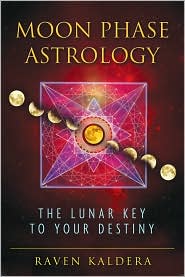
Kaldera is the author of Pagan Astrology and MythAstrology and is a Northern Traditional pagan. The eight lunar phases described by Dane Rudhyar in The Lunation Cycle are the basis of the material in the book. In the course of twelve lunar cycles, the eight phases occur in all twelve signs. This creates 96 different moon/phase/zodiac sign combinations, and descriptions of those 96 combinations are the bulk of the book. These descriptions are intended to help the reader better understand the archetypal patterns of his/her natal moon.
The book begins with an introduction and an instruction guide called “How To Use This Book: For The Complete Beginner.” The author attempts to give novices enough information to look up their natal moon sign, moon phase, and planetary aspects. It would be interesting to see if a raw beginner could succeed without assistance. Although it’s evident that a lot of effort went into this critical chapter, it flounders. I went cross-eyed reading the instructions for finding planetary aspects and finally gave up. (Save yourself the headache—if you’re not an astrologer, ask one to tell you what they are.)
The 96 moon-phase-signs occupy the majority of the book (from pages 23 to 354). The descriptions are organized by phases: twelve new moons through the signs (Aries through Pisces): twelve waxing crescent moons (Aries through Pisces), etc. Each moon-sign-phase is given an imaginative title that describes its archetype. For example, the waxing 1st quarterly moon in Libra is the “Black Knight” moon. The gibbous 2nd quarter moon in Aquarius is the “Trickster’s” moon. New to first-quarter moons are infant or children archetypes and tend to involve patterns with parents, self-discovery, and sibling relationships. First quarter to full moons feature more complicated, sometimes conflicted, characters whose titles reflect individual roles, professions or vocations. Elder archetypes complete the series past the third quarter.
Each segment describes psychological drives, behavior patterns, emotional and relating styles. In some signs, lunar emotions are sublimated, repressed or suppressed, and the potential consequences are outlines. A brief paragraph relating to the transiting moon in the particular sign/phase offers suggestions for activities and things to think about. At the end of each segment there’s a collection of relevant quotes.
This book offers an awful lot of content, but does it work? The effort to make astrology more accessible to pagans is laudable, but, in my opinion, there are problems and flaws with how the material was presented, with its applications, and even with the astrology itself. To wit, only outer planet sign rulers are considered, and that is a serious flaw. At best, the outer-planets are co-rulers of Scorpio, Aquarius and Pisces, and an increasing number of astrologers would say they don’t rule those signs at all.
Moon-sign descriptions are meant to be synthesized with a ton of other astrological factors. The natal moon’s aspects with planets are critical in the type of humanistic astrology that Kaldera works with, and can have a profound impact on the way the natal moon is expressed. The solution the author gives is to advise the reader to consider descriptions of other moon-sign-phases as proxies for planetary aspects. I tried this with my own lunar aspects and it didn’t work very well.
The biggest issue I had with this book is that it has very limited applications. Information on transit meanings, applications and activities should have been separated from the natal musings and treated in more depth. The concept would have been more successful (and the book more useful) if it had centered on transits and progressions, and the descriptions ordered so the reader could follow, page by page, through an entire lunar year. Natal placements are static, and transits are brief, so progressions would have offered a meaty application that would have invited repeated visits to this text. The quotes are cute but not critical to the material.
This text demonstrates why the attempt to write a book appealing to novices and experienced astrologers is a dicey proposition. Compromises made for beginners compel the author to dumb down the material, limit the extent of the material’s application and the less-useful order of the descriptions. And the concept, which is a good one, would appeal more to pagans if it was sequential and didn’t involve looking up natal information at all. Overall, it seems that the moon-sign-phase descriptions would find a better application in a computer-generated astrology report program.
Since so much thought and effort went into writing this book, it’s a shame that the potential uses and purposes of the material weren’t considered in greater depth. Pagans, astrologers, and beginning astrologers are very separate and distinct consumer groups. Attempting to create material that appeals and is useful to all three groups is an exercise in futility; the content suffers, and so do the readers. Although the writing is good, the end result is less satisfying than it could have been and deserves to be.
~review by Elizabeth Hazel
Author: Raven Kaldera
Destiny Books (Inner Traditions), 2011
pp. 355, $19.95
